Gregory A. Fournier's Blog, page 16
April 18, 2019
Detroit's Beloved Weatherman Sonny Eliot
[image error]
Sonny Eliot and friend.Weatherman Sonny Eliot was well-known to generations of Detroiters. He began his career in 1947 at the very beginning of television broadcasting in Detroit and spent thirty-five years at WWJ (now WDIV), which included seventeen years hosting "At the Zoo." For many years, he was the Master of Ceremonies for Detroit's J.L. Hudson's Thanksgiving Day Parade. In 2010, Eliot retired from broadcasting.
Sonny Eliot was a cultural icon for Baby Boomers and their parents. Once called the Ernie Harwell (Detroit Tiger sportscaster) of weather, Eliot had an unprecedented 50% share of Detroit's television market during his weather segment. Perhaps he is best described as a borscht-belt comic weatherman and best known for his hybrid blending of weather conditions like "snog" for snow/fog, "cloggy" for cloudy/foggy, and "droudy" for dreary/cloudy. In addition to his television career, he was the author of four children's books. Eliot had a wonderful sense of humor and loved to make people laugh.
Marvin Schlossberg was born on Hastings Street December 5, 1920. He was the youngest child of Latvian Jewish parents. His mother nicknamed him "Sonny." He credits his mother for his sense of humor. His parents owned and ran a hardware store on Detroit's East Side. As he grew up, Sonny developed a passion for flying.
 B-24 Liberator bomber"During World War II, he was a B-24 bomber pilot who was shot down over Germany. Flak tore into his plane in February of 1944. He held the bomber as steady as he could while his crew parachuted before he jumped. Sonny was apprehended by a German farmer armed with a pitchfork and spent eighteen months in Stalagluft I until the end of the war. The POW camp was located near Barth, Germany. It was liberated the night of April 30, 1945, by Russian troops. The American prisoners were soon evacuated by American aircraft in "Operation Revival" and returned home.
B-24 Liberator bomber"During World War II, he was a B-24 bomber pilot who was shot down over Germany. Flak tore into his plane in February of 1944. He held the bomber as steady as he could while his crew parachuted before he jumped. Sonny was apprehended by a German farmer armed with a pitchfork and spent eighteen months in Stalagluft I until the end of the war. The POW camp was located near Barth, Germany. It was liberated the night of April 30, 1945, by Russian troops. The American prisoners were soon evacuated by American aircraft in "Operation Revival" and returned home.
Mel Butsicaris, son of Johnny Butsicaris and nephew of Jimmy Butsicaris, the Lindell AC bar owners, gave me permission to share his Facebook post on the Sonny Eliot he knew.
"Sonny was an incredible man and many stories have been told and written about his life. He lived, worked, and played in Detroit, so people felt like they knew him because he would take the time to acknowledge them. Uncle Sonny is what I called him. He was a unique man and a joy to be around: funny, smart, adventurous, generous, and fun-loving. He fit in with anybody he was with.
"People would see Uncle Sonny hanging out at the Lindell AC (Athletic Club) sports bar during the week. My dad even gave him an office on the second floor of our building. But on the weekends he focused on his two loves--his wife Annette and flying with my dad in an airplane they co-owned. Flying was their shared addiction.
"Uncle Sonny made everyone feel like a friend, so people naturally felt like they knew him. I have lost track of how many times people have come up to me and say they saw Sonny Eliot drunk at the Lindell feeling no pain, or Sonny was so funny after he had a few drinks. Newsflash! Sonny Eliot did not drink alcohol.
"To all the people that bought Uncle Sonny a drink in the Lindell, I am sorry for overcharging you, but you insisted I make him a drink. I would give him his usual glass of soda water with a splash of ginger ale for some color and a lemon twist. I would put my finger over the pour spout so it only looked like he was getting whiskey. His drinking was an act, but his wit, fun-loving personality, and his genuine kindness were real."
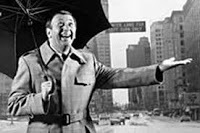 Marvin (Sonny Eliot) Schlossberg died peacefully among family and friends in his Farmington Hills home on November 16, 2012, at the age of ninety-one. Sonny Eliot led a remarkable life touching the lives of millions of Detroiters and leaving us better for the experience.
Marvin (Sonny Eliot) Schlossberg died peacefully among family and friends in his Farmington Hills home on November 16, 2012, at the age of ninety-one. Sonny Eliot led a remarkable life touching the lives of millions of Detroiters and leaving us better for the experience.
WWJ video tribute to Sonny Eliot--https://youtu.be/Y0iVuyfDUjM
Sonny Eliot news story: https://www.youtube.com/watch?v=lZD-gKG5-g8
Sonny Eliot was a cultural icon for Baby Boomers and their parents. Once called the Ernie Harwell (Detroit Tiger sportscaster) of weather, Eliot had an unprecedented 50% share of Detroit's television market during his weather segment. Perhaps he is best described as a borscht-belt comic weatherman and best known for his hybrid blending of weather conditions like "snog" for snow/fog, "cloggy" for cloudy/foggy, and "droudy" for dreary/cloudy. In addition to his television career, he was the author of four children's books. Eliot had a wonderful sense of humor and loved to make people laugh.
Marvin Schlossberg was born on Hastings Street December 5, 1920. He was the youngest child of Latvian Jewish parents. His mother nicknamed him "Sonny." He credits his mother for his sense of humor. His parents owned and ran a hardware store on Detroit's East Side. As he grew up, Sonny developed a passion for flying.
 B-24 Liberator bomber"During World War II, he was a B-24 bomber pilot who was shot down over Germany. Flak tore into his plane in February of 1944. He held the bomber as steady as he could while his crew parachuted before he jumped. Sonny was apprehended by a German farmer armed with a pitchfork and spent eighteen months in Stalagluft I until the end of the war. The POW camp was located near Barth, Germany. It was liberated the night of April 30, 1945, by Russian troops. The American prisoners were soon evacuated by American aircraft in "Operation Revival" and returned home.
B-24 Liberator bomber"During World War II, he was a B-24 bomber pilot who was shot down over Germany. Flak tore into his plane in February of 1944. He held the bomber as steady as he could while his crew parachuted before he jumped. Sonny was apprehended by a German farmer armed with a pitchfork and spent eighteen months in Stalagluft I until the end of the war. The POW camp was located near Barth, Germany. It was liberated the night of April 30, 1945, by Russian troops. The American prisoners were soon evacuated by American aircraft in "Operation Revival" and returned home.Mel Butsicaris, son of Johnny Butsicaris and nephew of Jimmy Butsicaris, the Lindell AC bar owners, gave me permission to share his Facebook post on the Sonny Eliot he knew.
"Sonny was an incredible man and many stories have been told and written about his life. He lived, worked, and played in Detroit, so people felt like they knew him because he would take the time to acknowledge them. Uncle Sonny is what I called him. He was a unique man and a joy to be around: funny, smart, adventurous, generous, and fun-loving. He fit in with anybody he was with.
"People would see Uncle Sonny hanging out at the Lindell AC (Athletic Club) sports bar during the week. My dad even gave him an office on the second floor of our building. But on the weekends he focused on his two loves--his wife Annette and flying with my dad in an airplane they co-owned. Flying was their shared addiction.
"Uncle Sonny made everyone feel like a friend, so people naturally felt like they knew him. I have lost track of how many times people have come up to me and say they saw Sonny Eliot drunk at the Lindell feeling no pain, or Sonny was so funny after he had a few drinks. Newsflash! Sonny Eliot did not drink alcohol.
"To all the people that bought Uncle Sonny a drink in the Lindell, I am sorry for overcharging you, but you insisted I make him a drink. I would give him his usual glass of soda water with a splash of ginger ale for some color and a lemon twist. I would put my finger over the pour spout so it only looked like he was getting whiskey. His drinking was an act, but his wit, fun-loving personality, and his genuine kindness were real."
 Marvin (Sonny Eliot) Schlossberg died peacefully among family and friends in his Farmington Hills home on November 16, 2012, at the age of ninety-one. Sonny Eliot led a remarkable life touching the lives of millions of Detroiters and leaving us better for the experience.
Marvin (Sonny Eliot) Schlossberg died peacefully among family and friends in his Farmington Hills home on November 16, 2012, at the age of ninety-one. Sonny Eliot led a remarkable life touching the lives of millions of Detroiters and leaving us better for the experience.WWJ video tribute to Sonny Eliot--https://youtu.be/Y0iVuyfDUjM
Sonny Eliot news story: https://www.youtube.com/watch?v=lZD-gKG5-g8
Published on April 18, 2019 09:25
April 13, 2019
Willie O'Ree--National Hockey League Pioneer
 Willie and his family with Canadian Prime Mister Justin Trudeau.
Willie and his family with Canadian Prime Mister Justin Trudeau.I can not express how happy I am that my friend Willie O'Ree was inducted into the National Hockey League Hall of Fame in 2018. As if that wasn't enough, Willie was also awarded the Order of Canada medal by Prime Minister Trudeau. And now, a documentary about him is premiering April 29th at the 2019 Hot Docs Canadian International Documentary Festival in Toronto. An article and the trailer for the documentary is linked below.
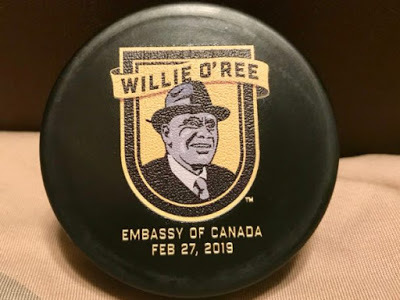 Commemorative Hockey PuckWillie and I met not on the ice but through our wives who were friends. Willie's wife is from Duncan, British Columbia; he is from Fredericton, New Brunswick; my wife is from Tucson, Arizona; and I'm from Detroit, Michigan. How we came together in time and space is one of those happy coincidences that seldom occur in life. When Sue and I married, Willie and Deljeet stood up for us at our ceremony along with my daughter Nicole and Sue's father Frank.
Commemorative Hockey PuckWillie and I met not on the ice but through our wives who were friends. Willie's wife is from Duncan, British Columbia; he is from Fredericton, New Brunswick; my wife is from Tucson, Arizona; and I'm from Detroit, Michigan. How we came together in time and space is one of those happy coincidences that seldom occur in life. When Sue and I married, Willie and Deljeet stood up for us at our ceremony along with my daughter Nicole and Sue's father Frank.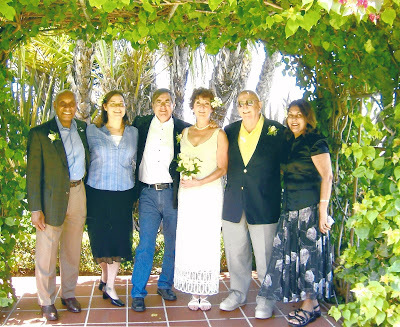 September 2007Willie told me that when he was a kid, his baseball team won a Canadian Little League championship and he got to meet Jackie Robinson. Robinson shook Willie's hand in a "meet and greet" in New York City. Robinson asked him if baseball was his favorite sport.
September 2007Willie told me that when he was a kid, his baseball team won a Canadian Little League championship and he got to meet Jackie Robinson. Robinson shook Willie's hand in a "meet and greet" in New York City. Robinson asked him if baseball was his favorite sport. Souvenir from Willie O'Ree Night at recent San Diego Gulls game.Willie said "No, it's hockey."
Souvenir from Willie O'Ree Night at recent San Diego Gulls game.Willie said "No, it's hockey."Robinson was surprised and replied, "Black people don't play hockey."
Willie reponded, "We do in Canada."
As an adult, Willie and Robinson met again in a celebrity pro/am golf tournament and Jackie remembered Willie as a kid. Since 1998, Willie has been the NHL Diversity Ambassador. The impression Willie leaves with people who meet him is they are in the presence of an unforgettable, outstanding human being.
Willie O'Ree documentary trailer
Published on April 13, 2019 09:53
April 10, 2019
Detroit’s Lindell AC - The Nation’s First Sports Bar
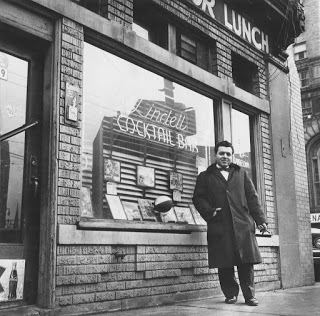 Johnny in front of the original Lindell Bar
Johnny in front of the original Lindell BarIn 1949, Greek immigrant Meleti Butsicaris with his sons—Johnny and Jimmy—leased the ground floor of the run-down Lindell Hotel and opened their bar on Cass and Bagley avenues. At first, they couldn’t afford to have a sign made with a different name, so they went with the hotel’s signage and called their tavern the Lindell Bar and the name stuck. The bar was near Briggs Stadium, where the Tigers and Lions played, and the Olympia arena, home of the Detroit Red Wings.
Legend has it that a young New York Yankee second baseman—Billy Martin—suggested to the brothers they change the drab atmosphere of the bar with an athletic theme. That would not be difficult. In addition to being co-owner of the bar, Johnny Butsicaris was also the official photographer for the Olympia. He had plenty of original sports photographs he could use. It was not long before sports memorabilia adorned the walls with autographed photos of Detroit sports stars, signed team jerseys, bats, and hockey sticks--even a jock strap belonging to Wayne Walker, a Detroit Lion linebacker. The new look helped define the bar’s clientele.
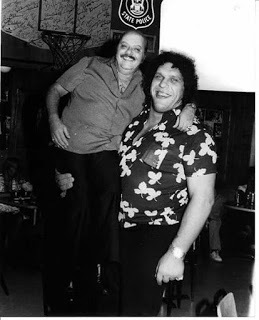 Jimmy with Andre the Giant.The Lindell soon became a hangout for Detroit sports figures and players from visiting teams. It wasn’t long before local sports writers and celebrities performing in Detroit found a home at the Lindell. National celebrities like Milton Berle and Jayne Mansfield would stop in. Local celebrities like Detroit’s favorite weatherman Sonny Eliot and Detroit Newssports columnist Doc Greene were regulars. Even the Beatles and their entourage went to the bar after their Olympia concert.
Jimmy with Andre the Giant.The Lindell soon became a hangout for Detroit sports figures and players from visiting teams. It wasn’t long before local sports writers and celebrities performing in Detroit found a home at the Lindell. National celebrities like Milton Berle and Jayne Mansfield would stop in. Local celebrities like Detroit’s favorite weatherman Sonny Eliot and Detroit Newssports columnist Doc Greene were regulars. Even the Beatles and their entourage went to the bar after their Olympia concert.The most notorious event in the history of the original Lindell Bar was a publicity stunt for a wrestling match between Detroit Lion defensive tackle Alex Karras and wrestler Dick the Bruiser. Karras needed the cash since he was no longer drawing his NFL salary. The week before, Karras was suspended from the NFL for the 1963 season for admitting he bet on football games.
 Karras and the Bruiser in publicity still.Karras was a friend of Dick the Bruiser from Karras's one season as a pro-wrestler. The Bruiser wanted to help his friend in need. The original idea was born in the mind of Dick the Bruiser. He proposed a publicity stunt in the Lindell Bar to increase the gate at the Olympia match. What began as a publicity stunt became a full-blown bar brawl. In the process, the Bruiser wrecked the bar. The scheduled wrestling match the following Saturday night earned Karras $30,000. [See the link below for more information on that incident]
Karras and the Bruiser in publicity still.Karras was a friend of Dick the Bruiser from Karras's one season as a pro-wrestler. The Bruiser wanted to help his friend in need. The original idea was born in the mind of Dick the Bruiser. He proposed a publicity stunt in the Lindell Bar to increase the gate at the Olympia match. What began as a publicity stunt became a full-blown bar brawl. In the process, the Bruiser wrecked the bar. The scheduled wrestling match the following Saturday night earned Karras $30,000. [See the link below for more information on that incident]The Butsicaris brothers took Karras on as a business partner with his $30,000 from the wrestling match. After the bar brawl, the three partners moved the location of the bar to Michigan and Cass avenues. They had no choice. The Lindell Hotel was condemned and scheduled for demolition.
Detroit News sports reporter Doc Greene suggested adding AC (Athletic Club) after the new bar’s name as a sly reference to the Detroit Athletic Club, an exclusive members-only club. Only the city’s business elite and socialites were members. Even famous sports figures could not enter the club without a special guest invitation from a member.
Doc Greene got many of his exclusive sports stories sitting at the original Lindell Bar. He did not want his bosses to know how much time he spent there getting his exclusive stories. In his Detroit News sports articles, he would write he was interviewing this or that athlete at the Athletic Club. It became an inside joke at the bar. Greene would call his wife and say he would be home soon when he was finished at the Athletic Club. As a tribute to Doc Greene, the reincarnated Lindell Bar became the Lindell AC.
Johnny’s son Mel Butsicaris remembers working the night an elephant was brought into the sports bar.
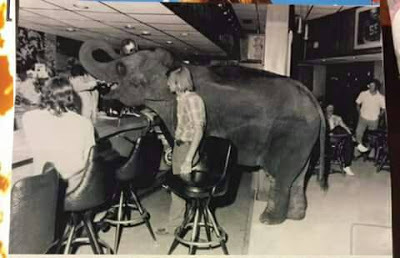 Sonny Eliot behind the bar at the Lindell AC. Photo courtesy of Mel Butsicaris.
Sonny Eliot behind the bar at the Lindell AC. Photo courtesy of Mel Butsicaris.“The most talked about photograph in the bar was not of an athlete or celebrity. Back in the 1970s, Bell Telephone and the Yellow Pages had a slogan about an elephant never forgetting, but you have the Yellow Pages for help. They were making a commercial across the street with a baby elephant.
 Sonny Eliot"You don’t see an elephant in downtown Detroit too often, so my dad and I walked over to watch. My dad told the film crew to come over to the bar and he’d buy everyone a drink. As a joke, my dad said while petting the elephant, ‘Bring your friend along.’ About an hour later, the front door opened with this guy pushing this beast through the door. We still can’t believe it, but the elephant fit through. We worried if the floor could handle the weight. Everyone had a good laugh when Sonny Eliot started giving the elephant Coca-Cola to drink. Shortly after, the Coke acted as a laxative for the animal. We used snow shovels to clean up the mess.”
Sonny Eliot"You don’t see an elephant in downtown Detroit too often, so my dad and I walked over to watch. My dad told the film crew to come over to the bar and he’d buy everyone a drink. As a joke, my dad said while petting the elephant, ‘Bring your friend along.’ About an hour later, the front door opened with this guy pushing this beast through the door. We still can’t believe it, but the elephant fit through. We worried if the floor could handle the weight. Everyone had a good laugh when Sonny Eliot started giving the elephant Coca-Cola to drink. Shortly after, the Coke acted as a laxative for the animal. We used snow shovels to clean up the mess.”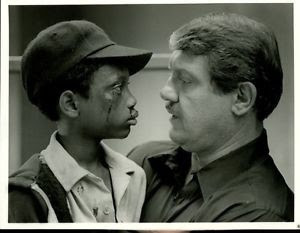 Alex Karras and Curtis YatesIn 1980, CBS filmed a made-for-television movie in the Lindell AC bar called Jimmy B. and Andres. It was based on the true story of Jimmy Butsicaris, who wanted to adopt an African-American boy. Alex Karras starred with his wife Sharon Clark, and as the young boy, Curtis Yates. The bar was sanitized as a restaurant for the movie. The spin off became the ABC sitcom Webster with Emmanuel Lewis playing the child’s role.
Alex Karras and Curtis YatesIn 1980, CBS filmed a made-for-television movie in the Lindell AC bar called Jimmy B. and Andres. It was based on the true story of Jimmy Butsicaris, who wanted to adopt an African-American boy. Alex Karras starred with his wife Sharon Clark, and as the young boy, Curtis Yates. The bar was sanitized as a restaurant for the movie. The spin off became the ABC sitcom Webster with Emmanuel Lewis playing the child’s role. Jimmy Butsicaris died in 1996, and his brother Johnny died in 2011. The Lindell AC sports bar, said to be the first in the nation, closed its doors in 2002. The building was scheduled for demolition to make way for the Rosa Parks Transit Center.
More information on the Alex Karras/Dick the Bruiser bar brawl: http://fornology.blogspot.com/2017/02/alex-karras-and-dick-bruisers-detroit.html
Published on April 10, 2019 06:42
March 22, 2019
Terror In Ypsilanti Gets Second Wind
 Seven months ago, I shelved my promotions for my previous books to concentrate on my current project about Detroit's Purple Gang. Then last week, I received a Canadian media company's inquiry about purchasing a two-year option for the audiovisual rights to develop Terror In Ypsilanti and promote a movie or cable series. No guarantees of course, but the executives at Big Coat Media are optimistic they can market a film project based on my true crime book--especially after the 2019 Netflix success of Extremely Wicked, Shockingly Evil, and Vile starring Zac Effron as Ted Bundy.
Seven months ago, I shelved my promotions for my previous books to concentrate on my current project about Detroit's Purple Gang. Then last week, I received a Canadian media company's inquiry about purchasing a two-year option for the audiovisual rights to develop Terror In Ypsilanti and promote a movie or cable series. No guarantees of course, but the executives at Big Coat Media are optimistic they can market a film project based on my true crime book--especially after the 2019 Netflix success of Extremely Wicked, Shockingly Evil, and Vile starring Zac Effron as Ted Bundy.The antagonist in my true crime Terror In Ypsilanti is Michigan serial killer John Norman Collins. Collins would be better known nationally if it wasn't for Charles Manson and his Family. One week into Collins's trial, the Helter Skelter murders blazed across the headlines drawing the national and international press to the Hollywood Hills leaving the Collins case in obscurity.
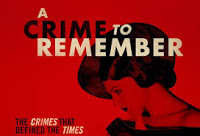
In 2013, Investigation Discovery produced a documentary for their Crimes to Remember series entitled "A New Kind of Monster." At the time, the working title of my book was The Rainy Day Murders. Before publication, I changed the title to Terror In Ypsilanti: John Norman Collins Unmasked. Collins was convicted for the murder of Karen Sue Beineman, which became the focus of I.D.'s program. But there were six other Collins murders he was never tried for. These brutal murders reveal his demoniacal contempt for women.
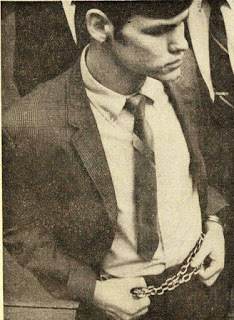 For three summers between 1967 until 1969, Collins stalked the college towns of Ypsilanti and Ann Arbor, Michigan creating terror among their residents and taking great satisfaction in taunting the Washtenaw County sheriff and the local police.
For three summers between 1967 until 1969, Collins stalked the college towns of Ypsilanti and Ann Arbor, Michigan creating terror among their residents and taking great satisfaction in taunting the Washtenaw County sheriff and the local police.I'm hoping this Canadian media opportunity reinvigorates the story and gives viewers a broader understanding of the crimes of John Norman Collins against seven young women who had the grim misfortune to cross his path.
Crimes to Remember "A New Kind of Monster"
Published on March 22, 2019 17:44
March 12, 2019
Purple Gangster Becomes Mr. Las Vegas
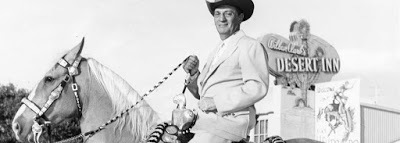 Moe Dalitz in Las Vegas publicity shot.
Moe Dalitz in Las Vegas publicity shot.Morris "Moe" Dalitz was born in Boston but his family moved to Detroit where he grew up in the same Black Bottom neighborhood with many of the original gang members who become known as the Purple Gang. During the gang's dominance controlling the illegal liquor business in Detroit, he and his father operated a small chain of cleaners and dyers businesses. Moe used their fleet of laundry trucks as a front to distribute Purple Gang liquor.
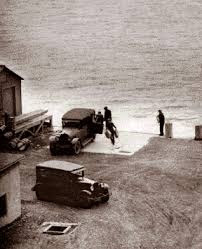 Moe learned the illegal liquor trade and became affiliated with the Little Jewish Navy--a faction of the Purples that controlled smuggling along the Detroit River. When three of their top leaders were brutally assassinated by their parent gang over an unpaid liquor debt, Moe relocated to Cleveland where he continued his bootlegging operation and opened a chain of mob-protected casinos in Ohio and Kentucky.
Moe learned the illegal liquor trade and became affiliated with the Little Jewish Navy--a faction of the Purples that controlled smuggling along the Detroit River. When three of their top leaders were brutally assassinated by their parent gang over an unpaid liquor debt, Moe relocated to Cleveland where he continued his bootlegging operation and opened a chain of mob-protected casinos in Ohio and Kentucky.Unlike many of his associates who spent their money as soon as they made it buying fancy clothes and flashy cars, Moe maintained a low public profile by investing in several legitimate businesses in Michigan. Dalitz held an executive position in the Michigan Industrial Laundry and the Colonial Laundry of Detroit where one of their services was laundering illicit gang money. He was also the president of Dalitz Realty Company in Wyandotte, Michigan that specialized in selling industrial-zoned tracts of land in the Downriver area.
Dalitz served stateside in the United States Army during World War II. While still wearing the uniform, he loaned Detroit Steel $100K to save a collapsing merger with Cleveland's Reliance Steel which proved profitable. In the late 1940s, Dalitz and his Cleveland and Detroit underworld backers using Teamsters' Union pension funds began investing in Las Vegas and lent front man Wilbur Clark--famous Las Vegas developer--the money to build the Desert Inn and then the Stardust casinos.
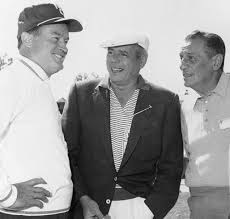 Dalitz with Bob Hope and Desi Arnez.Moe Dalitz became a gaming pioneer and a legend of the Las Vegas Strip. His casinos were one-stop resorts catering to a new demographic changing the face of the Las Vegas Strip catering to America's postwar, burgeoning middle class. Dalitz and his investors transformed Vegas from a gambling town to a vacation resort destination. Other organized crime figures took notice and began investing in Vegas also. This opened the door to the Midwest mob's infiltration of Las Vegas, which led to "skimming" off the top of the casinos' gross profits.
Dalitz with Bob Hope and Desi Arnez.Moe Dalitz became a gaming pioneer and a legend of the Las Vegas Strip. His casinos were one-stop resorts catering to a new demographic changing the face of the Las Vegas Strip catering to America's postwar, burgeoning middle class. Dalitz and his investors transformed Vegas from a gambling town to a vacation resort destination. Other organized crime figures took notice and began investing in Vegas also. This opened the door to the Midwest mob's infiltration of Las Vegas, which led to "skimming" off the top of the casinos' gross profits.Dalitz and other mob figures discovered a way to rehabilitate their images. In the early 1950s, they formed the Paradise Development Company which built the Las Vegas Convention Center, Sunrise Hospital, the Boulevard Shopping Mall, a championship golf course, and several buildings at the University of Nevada-Las Vegas. Dalitz became a philanthropic civic leader earning him the name Mr. Las Vegas.
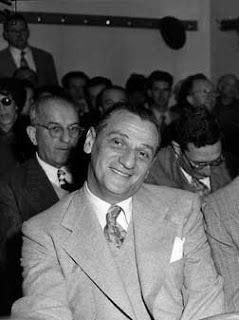 Dalitz at Kefauver crime hearing.Dalitz came from the rough world of the Purple Gang in Detroit and the Mayfield Road Mob in Cleveland. Despite his great success as a businessman and philanthropist in Vegas, Dalitz was never able to completely shed his associations with organized crime figures. He was called to testify before the Estes Kefauver Crime Hearings on February 27, 1951.
Dalitz at Kefauver crime hearing.Dalitz came from the rough world of the Purple Gang in Detroit and the Mayfield Road Mob in Cleveland. Despite his great success as a businessman and philanthropist in Vegas, Dalitz was never able to completely shed his associations with organized crime figures. He was called to testify before the Estes Kefauver Crime Hearings on February 27, 1951.Senator Kefauver asked Dalitz, "We have sworn testimony that you lent Detroit Steel $100,000 for $10,000 worth of company stock. You made $230,000 from that deal, didn't you?"
"Maybe more," was his unapologetic answer. "When I cast bread upon the waters, it comes back cake."
"Mr. Dalitz, didn't you make your original fortune as a rum runner?"
"I didn't inherit any money, that's for sure," Dalitz responded sidestepping the question.
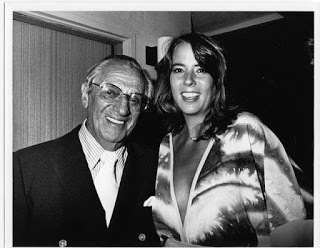 Moe with only daughter Suzanne.Fifteen years later on August 10, 1966, Dalitz was subpoenaed to testify before the Nevada Gaming Commission about the skim and payments to underworld figures. The government was closing in on organized crime organizations who controlled the casinos behind the scenes. The underworld was looking for a way out of the casino business.
Moe with only daughter Suzanne.Fifteen years later on August 10, 1966, Dalitz was subpoenaed to testify before the Nevada Gaming Commission about the skim and payments to underworld figures. The government was closing in on organized crime organizations who controlled the casinos behind the scenes. The underworld was looking for a way out of the casino business.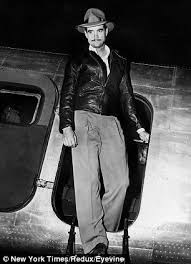 Howard HughesDeliverance came in the guise of Texas billionaire and movie mogul Howard Hughes. Hughes moved from Boston and rented the penthouse of the Desert Inn to live in seclusion as an eccentric hermit. Dalitz wanted Hughes out of the suites because the holiday season was approaching and "high rollers"--important to the Desert Inn's bottom line--had reservations for those rooms. Hughes didn't gamble. Dalitz had tense negotiations with Hughes over the eviction. Weary of Dalitz's threats, Hughes asked him how much he wanted for the Desert Inn. Dalitz said $13,250,000. Hughes wrote out a check and told Dalitz "Get the Hell out of my casino." Hughes lived there for four more years until 1976 when he was rushed to Houston, Texas where he died.
Howard HughesDeliverance came in the guise of Texas billionaire and movie mogul Howard Hughes. Hughes moved from Boston and rented the penthouse of the Desert Inn to live in seclusion as an eccentric hermit. Dalitz wanted Hughes out of the suites because the holiday season was approaching and "high rollers"--important to the Desert Inn's bottom line--had reservations for those rooms. Hughes didn't gamble. Dalitz had tense negotiations with Hughes over the eviction. Weary of Dalitz's threats, Hughes asked him how much he wanted for the Desert Inn. Dalitz said $13,250,000. Hughes wrote out a check and told Dalitz "Get the Hell out of my casino." Hughes lived there for four more years until 1976 when he was rushed to Houston, Texas where he died.The Desert Inn sale marked a seismic shift in the ownership of Las Vegas Strip casinos. Corporate interests and billionaire financiers like Kirk Kerkorian were the only entities with the kind of money to buy out the mob. Groups like Bally's, MGM, and Conde Nast ushered in the postmodern corporate era in Vegas we are familiar with today.
 La Costa Resort and Spa.Dalitz and his backers didn't get out of the resort business entirely. They moved to San Diego County and purchased the La Costa Resort and Hotel for $4,250,000 which catered to wealthy Americans and aging wise guys looking to escape winter weather back East. On August 31, 1989, Moe Dalitz died in Las Vegas of congestive heart failure and kidney disease at the age of eighty-nine.
La Costa Resort and Spa.Dalitz and his backers didn't get out of the resort business entirely. They moved to San Diego County and purchased the La Costa Resort and Hotel for $4,250,000 which catered to wealthy Americans and aging wise guys looking to escape winter weather back East. On August 31, 1989, Moe Dalitz died in Las Vegas of congestive heart failure and kidney disease at the age of eighty-nine.Suzanne Dalitz, her Dad, and the Vegas Mob Museum
Published on March 12, 2019 08:45
March 3, 2019
Lutes Casino, Yuma, Arizona
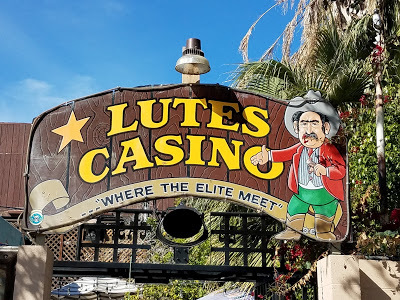
When I drive to Tucson from San Diego, I always stop in Yuma at Lutes Casino just across the California and Arizona state line--the Colorado River. Lutes is one of the premiere dive restaurants in the United States. Despite its name, the only gambling that goes on is the sale of Arizona lottery tickets. The building was constructed in 1901 as a dry goods store called The New York Store. In 1920, a pool hall moved into the building, and Lutes still has pool tables making it the longest operating pool hall in Arizona. The restaurant/bar specializes in basic American bar food--nothing fancy but always good.
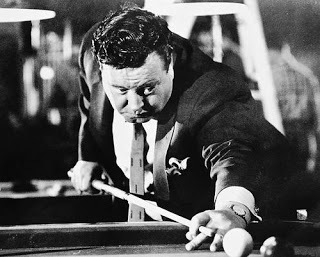 Robert Henry (R.H.) Lutes acquired the business in 1944 as payment for a $10,000 debt. The sixty-eight-year-old Arizona landmark has the look, feel, and smell of an old-time saloon because that's what it is. The twelve-foot-high walls are festooned with old movie posters and photographs of Hollywood icons and vintage neon signs. Lutes displays the most eclectic collection of what-nots on every available surface. The ceiling is hung with all sorts of oddities. The chotchkies are less a collection than an eye-popping assault on the senses. One wall has pinball machines and modern coin operated games, and the pool tables are at the back. The place is also a domino parlor.
Robert Henry (R.H.) Lutes acquired the business in 1944 as payment for a $10,000 debt. The sixty-eight-year-old Arizona landmark has the look, feel, and smell of an old-time saloon because that's what it is. The twelve-foot-high walls are festooned with old movie posters and photographs of Hollywood icons and vintage neon signs. Lutes displays the most eclectic collection of what-nots on every available surface. The ceiling is hung with all sorts of oddities. The chotchkies are less a collection than an eye-popping assault on the senses. One wall has pinball machines and modern coin operated games, and the pool tables are at the back. The place is also a domino parlor.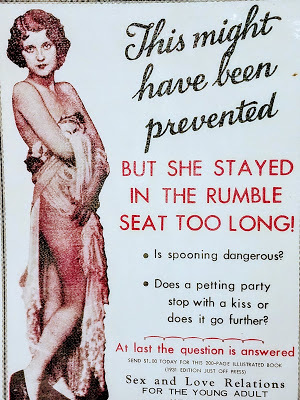 Before R.H. Lutes became a casino/restaurant owner, he was Yuma's Justice of the Peace and coroner. R.H. is said to have married 18,000 people and buried 905. He was Justice of the Peace until 1952. In the 1930s, he opened the Gretna Green Wedding Chapel named after a famous Scottish marriage destination.
Before R.H. Lutes became a casino/restaurant owner, he was Yuma's Justice of the Peace and coroner. R.H. is said to have married 18,000 people and buried 905. He was Justice of the Peace until 1952. In the 1930s, he opened the Gretna Green Wedding Chapel named after a famous Scottish marriage destination. During the war years, he married many military personnel. Prior to 1957, Arizona did not require a blood test or a three-day waiting period. In Yuma's marriage mill heyday, there were a dozen wedding chapels.
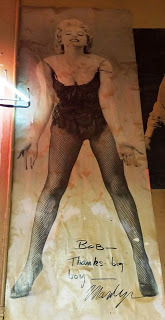 Yuma became a favorite wedding destination for many of Hollywood's famous 1930s and 1940s actors and actresses. Most of the celebrities simply wanted to escape publicity and the studio spotlight--people like Constance Bennett, Charlie Chaplin, John Barrymore, Claudette Colbert, Gilbert Roland, Franchot Tone, Victor Mature, Charles Boyer, Alice Faye, Tony Martin, Bette Davis, Loretta Young, Buster Crabbe, Gloria Swanson, Mary Astor, and studio mogul Louis B. Mayer.
Yuma became a favorite wedding destination for many of Hollywood's famous 1930s and 1940s actors and actresses. Most of the celebrities simply wanted to escape publicity and the studio spotlight--people like Constance Bennett, Charlie Chaplin, John Barrymore, Claudette Colbert, Gilbert Roland, Franchot Tone, Victor Mature, Charles Boyer, Alice Faye, Tony Martin, Bette Davis, Loretta Young, Buster Crabbe, Gloria Swanson, Mary Astor, and studio mogul Louis B. Mayer.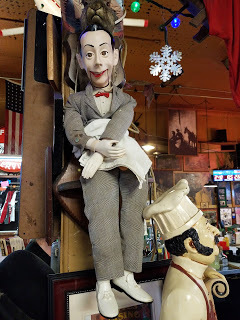 When blood tests eventually were required in Arizona, Lutes opened a serology lab run by his son Bill, who was a graduate of University of Arizona in biological sciences. If a groom or bride tested positive for disease, the law stated that if the infected party was undergoing treatment, he or she could still be married. "Cupid with a Hypodermic"--Dr. Roy R. Knotts--would give the infected person a shot so the couple could marry. The year before the blood test was required, the Yuma county clerk issued 18,000 marriage licenses. The following year, the figure dropped to 2,000.
When blood tests eventually were required in Arizona, Lutes opened a serology lab run by his son Bill, who was a graduate of University of Arizona in biological sciences. If a groom or bride tested positive for disease, the law stated that if the infected party was undergoing treatment, he or she could still be married. "Cupid with a Hypodermic"--Dr. Roy R. Knotts--would give the infected person a shot so the couple could marry. The year before the blood test was required, the Yuma county clerk issued 18,000 marriage licenses. The following year, the figure dropped to 2,000.Not every Hollywood movie star got married in Yuma to escape the press. Western movie star Tom Mix and his co-star Mabel Ward were married on the steps of the Yuma County Courthouse before 3,000 guests--memorialized by Yuma Daily Sun photographer Bob Werley.

Ghost Adventures in Lutes Casino on Travel Channel
Published on March 03, 2019 13:47
March 2, 2019
Literary Classics: Author Gregory A. Fournier on his award-winning bo...
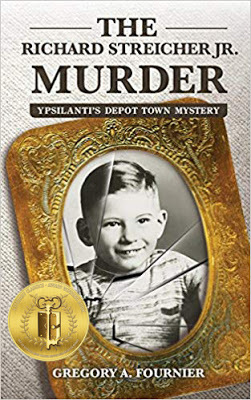
Literary Classics interviewed me a couple of months ago in concert with my Gold Medal award in their 2018 crime category for The Richard Streicher Jr, Murder: Ypsilanti's Depot Town Mystery.

Looking forward to the awards ceremony in Rapid City, South Dakota this May--especially a tour of Mt. Rushmore and the Crazy Horse Memorial. Many thanks.
Author interview: Literary Classics: Author Gregory A. Fournier on his award-winning bo...:
Published on March 02, 2019 07:57
February 23, 2019
Detroit's Greektown Stella - Iconic Homeless Woman Remembered
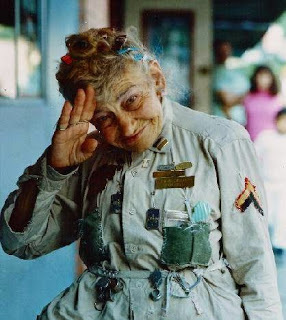 Photo taken of Stella Paris by a Detroit PolicemanI hadn't seen or heard of Greektown Stella for several decades, then several days ago, I found out that she had died almost seven years earlier on January 16th, 2011. When I saw her photograph on a recent Facebook post on the Old Delray/Old Detroit site, I knew that face and suddenly felt very sad. Whenever I go to a Greek restaurant or see the film Zorba, the Greek, I privately think of the crazy old Greek woman who patrolled the dimly lit Greektown neighborhood in Detroit from the late1960s until the early 1990s.
Photo taken of Stella Paris by a Detroit PolicemanI hadn't seen or heard of Greektown Stella for several decades, then several days ago, I found out that she had died almost seven years earlier on January 16th, 2011. When I saw her photograph on a recent Facebook post on the Old Delray/Old Detroit site, I knew that face and suddenly felt very sad. Whenever I go to a Greek restaurant or see the film Zorba, the Greek, I privately think of the crazy old Greek woman who patrolled the dimly lit Greektown neighborhood in Detroit from the late1960s until the early 1990s.Stella was a modern day Cassandra that nobody wanted to listen to. Over forty years ago, whenever my friends and I would go to Greektown for dinner or shop at Trappers' Alley, Stella was often ranting something in Greek or broken English at the top of her lungs at all hours of the night. Stella's piercing voice would echo off the brick buildings. She was impossible to ignore. Because she was a permanent fixture on Monroe Street, we quipped that she was being paid by the restaurant owners to provide local color for the Greek neighborhood.
Several newspaper accounts at the time of her death list Stella Paris' age at ninety-five or older. No birth certificate, citizenship, or immigration documentation exists for her, so she was denied public assistance. Stella is believed to have been born on the Greek island of Samos.
Doug Guthrie, writing for The Detroit News on January 21, 2011, discovered that "(Stella) had come to this country in 1938 through an arranged marriage to restaurant owner John Perris. She raised three sons and never wanted to learn English (but she spoke broken English of necessity). Stella was four feet, ten inches tall and very trim. She passed away from a heart condition. Stella's body was laid out at Annunciation Greek Orthodox Cathedral on East Lafayette Blvd.
In life, Stella suffered from mental illness and the scourge of schizophrenia. She had family who tried to take her in, but she wanted to be in Greektown where she felt comfortable, even when sleeping outside contending with the weather and other aggressive street people. She carried a nightstick for her protection, given to her by the police at the12th precinct downtown. "The Greek community took care of her by giving her food, shelter, and love," said Frank Becsi. "Stella is buried at Woodmere Cemetery."
"Stella was a blessing to me," says Shelley Rigney, someone who remembers her fondly. "I was young and she would always tell the 'Wolf' types not to bother me because my Momma knew Jack Tocco (Detroit Mafia Don) & my Pappa was a big crazy Irishman & I was the only baby girl in a house full of Big Boys. She would laugh and tell me, 'Ya justa keep walkin'. Don't you let any of that Trash even stick to your shoe.' God bless her sweet soul & kind heart... I still have ribbons and all the things she gave me."
Stella led the hard life of a homeless street person. Even when she was in her fifties, she looked much older than she was. A retired Detroit policeman who wishes not to be identified walked the Greektown beat for years. He tells a more sobering, less romantic story of Stella's street life.
"(Stella) claimed to be some sort of Greek princess, or that her late husband was the king of Greece, or some similar story.... She would hear voices and stand on the street corner and yell at the voices... you could hear her half a mile away on a calm day.
"She was your basic homeless bag lady, and unfortunately, her mind was not all there.... Stella's favorite motel was police headquarters at 1300 Beaubien, just up the street from Greektown. Some (of the officers) took her in as a mascot, providing her with some old marksmanship badges, chevrons, and a nightstick (billy club) that she carried faithfully....
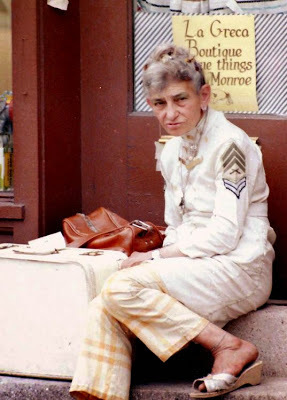 Stella on the street."I do know that many of the merchants in Greektown took pity on her regularly and provided her with food as needed. As I said, (Stella) was an icon. Actually, she was a perfect representative of so many mentally challenged people in the United States today."
Stella on the street."I do know that many of the merchants in Greektown took pity on her regularly and provided her with food as needed. As I said, (Stella) was an icon. Actually, she was a perfect representative of so many mentally challenged people in the United States today."Detroit policewoman Cynthia Hill said, "From our perspective, she never meant any harm. When I was working as a teenage police cadet, I noticed the officers let her sleep in the basement (of police headquarters) and bathe in our sinks in the women's restroom on the first floor. At first, she scared me. They told me, 'It's just Stella.' Later when I became an officer, I would see her on the street and feel the same way."
News of his mother's death came as a surprise to her seventy-year-old son, Anthony Perris of Livonia. He told The Detroit News that her life began on the streets when she was in her fifties. "The family assumed she had died fifteen years ago when she disappeared from Greektown," Perris said. "We didn't know that she had been ordered by a judge into an assisted care facility because she was brandishing a knife."
Stella Paris spent the last years of her life peacefully at the East Grand Nursing Home on East Grand Blvd. At the time, the facility desperately searched for any relative who could shed light on her immigration status. Because of the common misspelling of her real last name, the Perris family was never notified. Stella was indigent, so the nursing home took her under its protective care. But when Stella needed heart surgery, they were simply not in any position to pay for her hospital bills.
We have all seen homeless people in our communities. Some do their best to be unobtrusive or obsequious, while others rant and rave, wrestling with their personal demons. They are all desperate people living a tooth and nail existence. In our several encounters with Greektown Stella, my wife and I tried our best to avoid and not engage her in conversation because we didn't know what to expect. I regret that decision now.
Shelley Rigney laments, "Stella was a woman who was tossed aside by many, but she still managed to survive somehow. Now I wish I would have taken time for her. She had a lot to say and teach others."
Finding out about Greektown Stella's death brought it all back to me. Rather than our scorn and apathy, these people need acts of kindness and generosity, not only during the holiday season but throughout the entire year.
More on Stella can be found in this link: http://www.mlive.com/news/detroit/index.ssf/2010/01/greektown_stella_shouts_no_mor.html
Published on February 23, 2019 10:02
February 11, 2019
Detroit's Edgewater Park--A Fading Memory
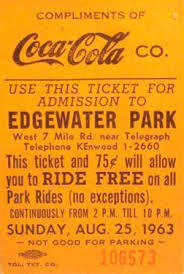 Pay-One-Price TicketThe Rouge River ran behind Edgewater Park--a twenty-acre amusement park on the West Side of Detroit. The park opened in 1927 on West 7 Mile Road and Grand River--just in time for Depression and World War II generations to escape the dire headlines while having some fun and diversion during hard times.
Pay-One-Price TicketThe Rouge River ran behind Edgewater Park--a twenty-acre amusement park on the West Side of Detroit. The park opened in 1927 on West 7 Mile Road and Grand River--just in time for Depression and World War II generations to escape the dire headlines while having some fun and diversion during hard times. Throughout the 1950s and 1960s--my era--the amusement park was one of the most popular recreation spots in the Detroit area. When we were kids, my parents took us to the park every year or so, but when my friends and I started to drive, Edgewater park was a regular after dark destination. We drove north up Telegraph Road from Dearborn Heights. It took no time at all to get to this oasis of affordable amusement and cheap thrills.
Popular rides and attractions were the one-hundred and ten foot tall Ferris Wheel with its great neon lighting effect at night, the Wild Mouse that would give riders whiplash, the always popular Dodge-Em cars, the reality-altering Hall of Mirrors, and the Fun House where many a male got to first base for the first time.
 Clicking and clacking before The Beast's first drop.Edgewater Park's premiere ride was a wooden roller coaster named "The Wild Beast." During the days of Pay-One-Price admission, some riders would see how many consecutive times they could ride The Beast in a day. I remember riding it seventeen times and having bruises all over my body afterward. One person claims to have ridden it twenty-seven times in one day, but I'm not certain how many of those rides were pre- or post- mortem. He must have worn protective clothing. The real record is lost to history.
Clicking and clacking before The Beast's first drop.Edgewater Park's premiere ride was a wooden roller coaster named "The Wild Beast." During the days of Pay-One-Price admission, some riders would see how many consecutive times they could ride The Beast in a day. I remember riding it seventeen times and having bruises all over my body afterward. One person claims to have ridden it twenty-seven times in one day, but I'm not certain how many of those rides were pre- or post- mortem. He must have worn protective clothing. The real record is lost to history.In the 1960s, the Teen Scene became a popular weekend spot. Admission to the park and the concert were included in the ticket price. Popular Motown groups often appeared at the park--as did the likes of Del Shannon and David Cassidy. Corn dogs, Coney dogs, cotton candy, and real French fries with malt vinegar drew teens to the park in huge numbers.
 Roller Coaster RuinsDeclining revenues and competition from modern steel roller coaster amusement parks like Cedar Point in Sandusky, Ohio proved to be more than the old park could handle. The last click of the turnstile was on September 13, 1981. The park operated for fifty-four years, but little is known of its history. Today, the site is home to the Greater Grace Temple.
Roller Coaster RuinsDeclining revenues and competition from modern steel roller coaster amusement parks like Cedar Point in Sandusky, Ohio proved to be more than the old park could handle. The last click of the turnstile was on September 13, 1981. The park operated for fifty-four years, but little is known of its history. Today, the site is home to the Greater Grace Temple.Photos of Edgewater Park: http://photos.metrotimes.com/15-nostalgic-photos-of-detroits-old-edgewater-amusement-park/#16
Published on February 11, 2019 07:08
January 18, 2019
Detroit's Pfeiffer Brewery and Johnny Pfeiffer
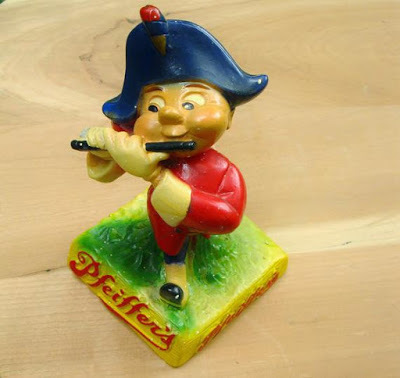
The Johnny Pfeiffer plaster-of-paris figurine depicts a Revolutionary War minuteman playing a fife. Designed by Walt Disney Studios in 1951 for the Pfeiffer Brewing Company, the back bar statuette was made by the Plasto Corporation in Chicago. A company spokesperson says Pfeiffer Brewing commissioned eight different versions of Johnny over the 1950s. Two thousand of the 7.25 inch figurines were produced every month making it the most common and least valuable statue they ever produced, currently selling on Ebay for $25 to $45 depending on condition and the motivation of the buyer.
Brewery founder Conrad Pfeiffer brought the original beer recipes from Germany in the late nineteenth century. The original styles were "Pfeiffer's Famous"--a light lager--and "Pfeiffer's Wurtzburger"--a dark lager. Their brew masters used only new seasoned white oak kegs and barrels to insure consistent quality and taste. Pfeiffer became Detroit's third most popular beer brand behind Stroh's and Goebel before Prohibition took effect in 1920.
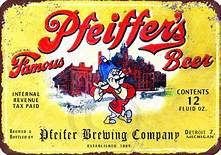
Repeal was passed by Congress and signed by President Franklin Roosevelt in December 1933, ending America's nightmare experience with Prohibition. Beginning in February 1934, Pfeiffer restored the exterior beauty of its original building built in 1889. The interior of the plant was completely remodeled, enlarged, and modernized. Legal beer shipments resumed on May 15, 1934.
Pfeiffer gained considerable market share after Prohibition repeal largely due to heavy-handed distributors who intimidated vendors and tavern owners to take their beer products over other brands. Complaints from vendors prompted the Michigan Liquor Commission to investigate Pfeiffer distributorships.
On February 22, 1935, Michigan Assistant Attorney General Gordon E. Tappan testified at a Liquor Commission public hearing that "(Pfeiffer Brewing Company) made no attempt to screen its distributors for character, qualifications, morals, or police records." Tappan charged the company and its agents with using strong-arm tactics to muscle in on Michigan's beer industry. The company made no attempt to rid itself of underworld influence.
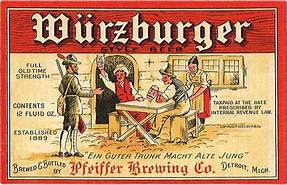
The Macomb Distribution Company had Mafia boss Joe "Uno" Zerilli and his underboss William "Black Bill" Tocco on their board of directors with Anthony Lambrecht, Alfred Epstein, Abe Rogoff, and H. Armin Weil, who also had police records. The board of Meyer's Products Company--another Pfeiffer distributor--included Donald F. Gray--president; Charles Leiter--vice-president and Oakland Sugar House Gang co-boss; Henry Shorr--treasurer and Sugar House Gang co-boss; Elda Ruffert--secretary; James Syla--manager; Sam "the Gorilla" Davis--company agent and known Purple Gang enforcer; and Henry Toprofsky--company agent and known Purple Gang enforcer.
Pfeiffer Brewery officials were required by the Michigan Liquor Control Commission to show cause why their brewing license shouldn't be revoked. Then president William G. Breitmeyer pled ignorance and said the company was having trouble keeping up with demand. They didn't need to force their products on anyone. On April 10, 1935, the company agreed to bar all persons with criminal records from serving as beer distributors and suspended their contracts. Despite the bad Depression-era publicity, Pfeiffer became Detroit's most popular brand overtaking Stroh's and Goebel by the end of the 1950s. But trouble was brewing on the horizon.
In the 1960s, Budweiser, Miller, and Pabst sought to become national brands. Because of their assets, access to capital, and huge advertising budgets, the Big Three brewers put many regional brewers out of business--not because of superior products but because of marketing and financial resources.
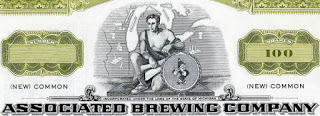
To compete with the Big Three, Pfeiffer changed its corporate name to Associated Brewing Company (ABC) in 1962. ABC acquired and consolidated smaller Midwestern brands and breweries to position itself in the national market, but they overextended themselves and became overburdened with debt. The old Pfeiffer brewery and bottling plant on Beaufait Avenue closed in 1966, and by 1972, the rest of ABC's remaining assets were sold off.
Detroiters are left with some aging memorabilia and a few random facts. In some small measure, the microbrewery movement of the twenty-first century is nipping at the heels of the national brands and cutting into their profits. Many of the old-style beers are once again available for our quaffing pleasure.
Many thanks Renee Reilly-Menard for gifting Johnny Pfeiffer to me along with the Vernor's gnome. The Detroit Historical Museum already has Johnny Pfeiffer in its collection. He looks good on my mantelpiece, I think I'll keep him.
Home for the gnome: https://fornology.blogspot.com/2019/01/vernors-gnome-found.html
Published on January 18, 2019 08:39



